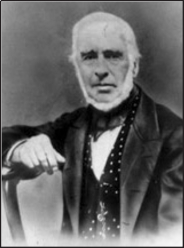- SAGEBIEN
- FRANCE (see also List of Individuals)\
 2.2.1807 Wavans/F - 9.10.1892 Boufflers/F\The Sagebien water wheel was one of the successful inventions of the 19th century. Alphonse-Eléonor Sagebien made his practical training in Châlons-sur-Marne, where an institution similar to Ecole des Arts et Métiers in Paris had been founded in the 1820s. Sagebien there graduated as an engineer in 1833. His interest then concentrated to geology in the Pas de Calais region, associated with mining engineering. Until 1848 he was fascinated in metallurgy when becoming interested in hydraulic machinery. These machines were required in mines, and Sagebien had realized the need for a better drainage of mining areas. The Sagebien wheel was the last important innovation of large water wheels in the 19th century, yet its design was never considered because it was heavy, spacious and relatively expensive yet its performance was unusually high thus explaining the interest in applications.\The success of the Sagebien wheel was between 1855 and 1875 prior to the introduction of hydro-electricity and after the steam machines had been in use. Its paddles are plane and the water undershoots the wheel. The entire machine is kept in a casing to control transverse water losses. The so called "breast wheel" may be considered a former design developed in England around 1820. That machine had received a theoretical appreciation of Gaspard-Gustave Coriolis (1792-1843) and Jean-Baptiste Bélanger (1790-1874). The latter proposed that a hydraulic jump at the tailwater of the wheel should be suppressed by adequate submergence. For large discharges, the approach flow depth was increased over the usual 20 cm and fewer paddles were inserted. Sagebien's invention involved a side wheel, the French Roue hydraulique de côté of which the prototype was built around 1845. The first documented wheel worked in 1851, containing all of the Sagebien elements, both with the particular intake and outlet elements. The paddles were arranged at an angle larger than 45° at the intake water elevation to inhibit an intake loss. The wheel worked for extremely low heads with an efficiency of up to 95%.\Belhoste, J.-F., Cartier, C. (1990). La roué Sagebien - Histoire d'une invention. Cahiers d'Histoire et de Philosophie des Sciences 29: 119-149.Sagebien, A. (1868). Expériences sur la roue hydraulique Sagebien, précédées d'un Exposé du principe de ce nouveau moteur à aubes immergentes et à niveau maintenu dans les aubes. Lacroix: Paris. http://messy.village.free.fr/mesjeu01.html P
2.2.1807 Wavans/F - 9.10.1892 Boufflers/F\The Sagebien water wheel was one of the successful inventions of the 19th century. Alphonse-Eléonor Sagebien made his practical training in Châlons-sur-Marne, where an institution similar to Ecole des Arts et Métiers in Paris had been founded in the 1820s. Sagebien there graduated as an engineer in 1833. His interest then concentrated to geology in the Pas de Calais region, associated with mining engineering. Until 1848 he was fascinated in metallurgy when becoming interested in hydraulic machinery. These machines were required in mines, and Sagebien had realized the need for a better drainage of mining areas. The Sagebien wheel was the last important innovation of large water wheels in the 19th century, yet its design was never considered because it was heavy, spacious and relatively expensive yet its performance was unusually high thus explaining the interest in applications.\The success of the Sagebien wheel was between 1855 and 1875 prior to the introduction of hydro-electricity and after the steam machines had been in use. Its paddles are plane and the water undershoots the wheel. The entire machine is kept in a casing to control transverse water losses. The so called "breast wheel" may be considered a former design developed in England around 1820. That machine had received a theoretical appreciation of Gaspard-Gustave Coriolis (1792-1843) and Jean-Baptiste Bélanger (1790-1874). The latter proposed that a hydraulic jump at the tailwater of the wheel should be suppressed by adequate submergence. For large discharges, the approach flow depth was increased over the usual 20 cm and fewer paddles were inserted. Sagebien's invention involved a side wheel, the French Roue hydraulique de côté of which the prototype was built around 1845. The first documented wheel worked in 1851, containing all of the Sagebien elements, both with the particular intake and outlet elements. The paddles were arranged at an angle larger than 45° at the intake water elevation to inhibit an intake loss. The wheel worked for extremely low heads with an efficiency of up to 95%.\Belhoste, J.-F., Cartier, C. (1990). La roué Sagebien - Histoire d'une invention. Cahiers d'Histoire et de Philosophie des Sciences 29: 119-149.Sagebien, A. (1868). Expériences sur la roue hydraulique Sagebien, précédées d'un Exposé du principe de ce nouveau moteur à aubes immergentes et à niveau maintenu dans les aubes. Lacroix: Paris. http://messy.village.free.fr/mesjeu01.html P
Hydraulicians in Europe 1800-2000 . 2013.
